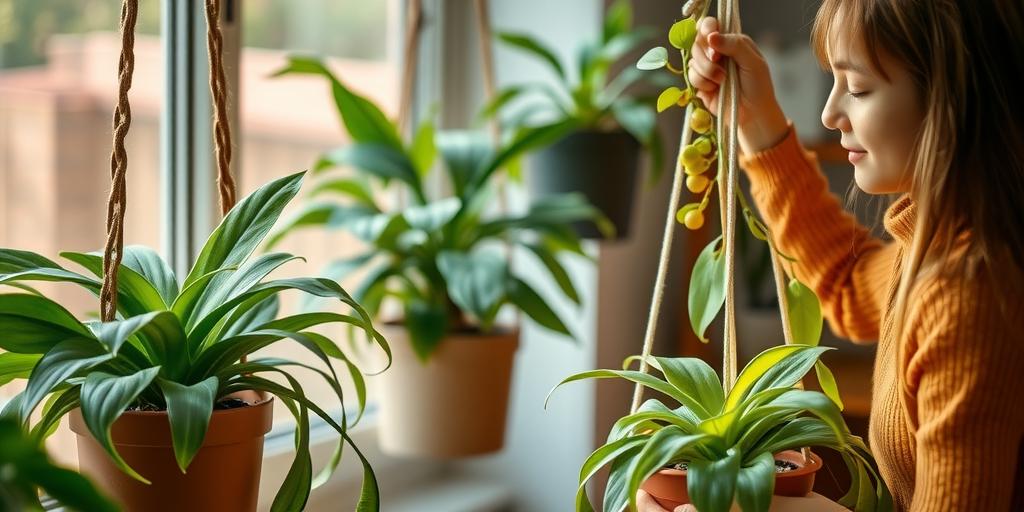
Essential Care Tips for Hanging Plants in Low Light Conditions
Discover essential care tips for hanging plants in low light conditions! Learn how to choose the right plants, optimize watering, and keep them thriving—even in dim spaces.
Introduction
Did you know that many popular hanging plants can thrive even in low light? While most plants crave sunlight, some varieties adapt beautifully to shady corners, making them perfect for apartments, offices, or rooms with limited natural light. But how do you keep them healthy? In this guide, we’ll share expert-approved tips to help your hanging plants flourish—no sunny windowsill required!
Best Hanging Plants for Low Light Conditions
Top Low-Light Tolerant Hanging Plants
If you’re working with limited natural light, some plants thrive better than others. Pothos (Epipremnum aureum) is a classic choice—it’s nearly indestructible and can survive in dim corners. Another great option is the Spider Plant (Chlorophytum comosum), which adapts well to low light and even produces cute little offshoots. Philodendrons, especially the heartleaf variety, are also excellent for hanging baskets in darker spaces. These plants don’t just survive—they add lush greenery even where sunlight is scarce.
Key Traits to Look for in Low-Light Hanging Plants
Not all plants handle low light equally well. Look for species with dark green leaves, as they contain more chlorophyll, helping them absorb light more efficiently. Slow-growing plants are another good bet—they don’t demand as much energy from limited light. Avoid plants with variegated leaves (like some types of Pothos), as they often need brighter conditions to maintain their patterns.
Where to Place Them for Optimal Light Exposure
Even in low-light spaces, placement matters. North-facing windows provide consistent but gentle light, making them ideal for shade-loving plants. If you’re keeping plants indoors, avoid deep corners too far from any window—instead, position them where they can catch indirect ambient light. For outdoor spaces like shaded patios or covered balconies, hanging plants where they get dappled light (rather than complete darkness) will keep them healthier.
Watering Strategies for Low-Light Hanging Plants
How Low Light Affects Watering Needs
Plants in low light grow slower, which means they use less water. Since evaporation is reduced, the soil stays moist longer. Overwatering is a bigger risk than underwatering in these conditions. Always adjust your watering schedule based on light levels—plants in dim areas might need water half as often as those in bright spots.
Signs of Overwatering vs. Underwatering
Yellowing leaves, especially at the base, often signal overwatering and possible root rot. If the soil feels soggy days after watering, you’re likely giving too much. On the other hand, underwatered plants may have dry, crispy leaf edges or drooping stems. A simple finger test—checking if the top inch of soil is dry—can help you decide when to water.
Best Watering Practices
To avoid waterlogged roots, always use well-draining pots with drainage holes. Water thoroughly, but let excess water escape—never let plants sit in standing water. In low light, wait until the top 1-2 inches of soil are dry before watering again. If you’re unsure, err on the side of underwatering; most low-light plants recover better from drought than from rot.
Soil and Fertilizer Tips for Healthy Growth
Ideal Soil Mix for Low-Light Hanging Plants
A lightweight, peat-based potting mix works well because it retains some moisture without becoming waterlogged. Adding perlite or orchid bark improves aeration, preventing soil compaction. Avoid heavy garden soil—it holds too much water and can suffocate roots in low-light conditions.
How Often to Fertilize in Low Light
Since low-light plants grow slower, they need less fertilizer. Over-fertilizing can lead to salt buildup and burn roots. A diluted, balanced liquid fertilizer (half-strength) every 6-8 weeks during the growing season (spring/summer) is usually sufficient. Skip fertilizing in winter when growth nearly stops.
Organic vs. Synthetic Fertilizers—Pros and Cons
Organic fertilizers (like worm castings or fish emulsion) release nutrients slowly and improve soil health over time, but they can be smelly indoors. Synthetic fertilizers give quick results and are odor-free, but they risk salt buildup if overused. For low-maintenance plants, organic options are often the safer choice.
Preventing Common Problems in Low Light
Pests to Watch For
Low-light, high-humidity environments can attract spider mites (look for webbing) and fungus gnats (tiny flies around the soil). Wipe leaves regularly with a damp cloth to deter mites, and let soil dry out between waterings to prevent gnats. Sticky traps can help control flying pests.
How to Combat Leggy Growth
When plants stretch toward light, they become leggy with sparse leaves. To fix this, rotate your plants weekly so all sides get even exposure. Prune back long stems to encourage bushier growth. If possible, move them to a slightly brighter spot (but still out of direct sun).
Dealing with Mold or Mildew in Humid Conditions
Poor air circulation and damp soil can lead to white mold or mildew on the soil surface. Scrape off affected areas and reduce watering. A small fan nearby can improve airflow. For severe cases, repot with fresh soil and ensure the container has proper drainage.
Creative Display Ideas for Low-Light Spaces
Hanging Planters That Maximize Limited Light
Macramé hangers allow plants to dangle freely, catching light from multiple angles. Wall-mounted planters or shelves near windows make use of vertical space without crowding. Clear glass or acrylic planters can also help by allowing ambient light to filter through from different directions.
Grouping Plants for Visual Impact
Cluster plants at varying heights—hang some, place others on stands—to create depth. Mix textures, like pairing the trailing vines of Pothos with the full foliage of a Fern. Grouping also raises humidity slightly, benefiting the plants.
Using Artificial Grow Lights as a Supplement
If natural light is extremely limited, LED grow lights can fill the gap. Choose full-spectrum bulbs and position them 6-12 inches above plants. Run them for 6-8 hours daily to mimic natural daylight without overheating. Timers make it easy to maintain a consistent schedule.
Conclusion
Caring for hanging plants in low light doesn’t have to be tricky! By choosing the right plants, adjusting your watering routine, and providing proper soil and occasional feeding, you can create a lush, green oasis—even in the dimmest corners. Ready to transform your space? Start with a hardy Pothos or Spider Plant and watch them thrive!
